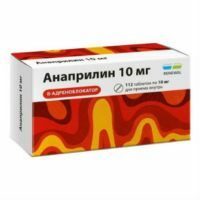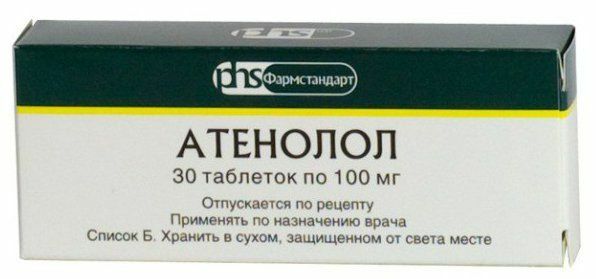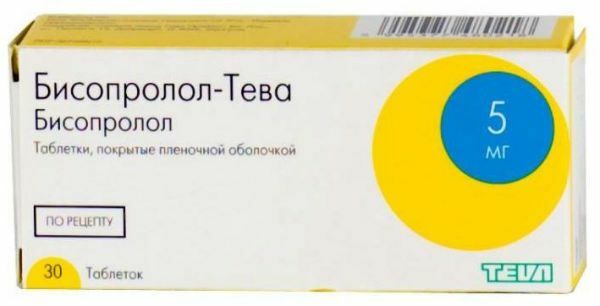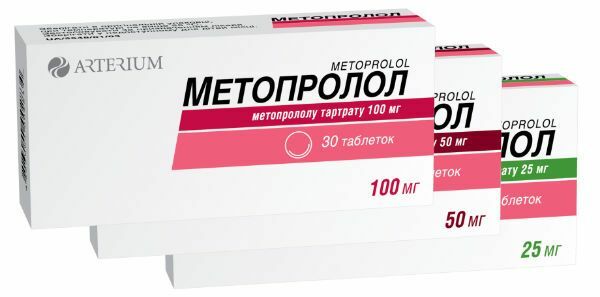
Anaprilin is an antihypertensive, antiarrhythmic drug that helps with high blood pressure and an increased heart rate. The drug itself is a non-selective adrenoblocker, but its modern analogs can selectively affect certain types of receptors, which reduces the burden on uninterested organs.
- Structure and Composition
- mechanism works
- Indications
- How to take
- Contraindications
- Side effects
- Overdose during pregnancy
- children with alcohol
- Analogs
- Atenolol
- Betaxolol( Lokren)
- bisoprolol
- Metoprolol
composition and the form
releaseThe active substance is propranolol hydrochloride.
Produced in the form of 1% and 25% injection solution and in tablets of 10 and 40 milligrams.
to contents ^Mechanism of operation
The action of Anaprilina on the heart is to block beta adrenoreceptors, and this reduces the strength and frequency of the heart rate( heart rate).In turn, the already weakened ability of the myocardium to contract significantly reduces the amount of cardiac output, reducing the need of the heart for oxygen.
In addition, propranolol reduces blood pressure and acts soothingly on the central nervous system.
Due to beta-adrenoreceptor blocking, bronchial tone is increased and uterine contractile function is increased, and the risk of bleeding during operations and delivery is reduced many times.
to contents ^Indications
Anaprilin helps with:
- Panic attacks and a sense of fear.
- Ischemic heart disease.
- Elevated pressure.
- Diseases during which the rhythm of the heart is disturbed( arrhythmia, ciliary tachycardia, tachycardia with thyrotoxicosis).
- Infarction.
- Migraines.
- Abstinence syndrome.
- Cardiac glycoside poisoning.
- Feeling of anxiety, fear.
- Eruptions of the central nervous system, which is accompanied by tachycardia and high blood pressure.
How to take
The drug should be taken orally half an hour before meals, washed down with plenty of water. The effect of Anaprilin depends on the method of taking: the whole tablet swallowed will work after 1.5-2 hours;If you put it under the tongue and dissolve, then the effect of the medication will begin after 15 minutes( although, for a short time, numbness of the tongue may be felt).
- When arrhythmias are recommended, take 10-30 milligrams of medication 3-4 times a day.
- When hypertension is prescribed 80 mg 2 times a day, but at a critically high pressure, the dose increases to 320 milligrams.
- When migraine is taken from 80 to 160 milligrams of the drug per day.
- With angina, anaprilin is taken according to the following scheme: from the first to the third day of treatment, 20 milligrams are taken 4 times a day, from the fourth to the sixth day, 40 milligrams 3 times a day, the fourth time 20 milligrams;the seventh day and further - 40 milligrams 4 times a day.
- To stabilize the condition after a heart attack, it is prescribed to 40 milligrams 4 times a day.
For a stronger and faster effect, Anaprilin is sometimes given in the ampoules parenterally. The usual dose is from 40 to 160 milligrams per day, but each diagnosis requires its dosage, for example, with angina in the first 3 days, 80 milligrams are prescribed, and from the fourth, 120 milligrams per day.
Average course of treatment Anaprilin usually lasts 3-4 weeks, but if necessary, it can be repeated after a month's break.
Discontinuation of Anaprilin should be gradual in order to avoid withdrawal syndrome, in which ischemic heart disease and poor physical exercise tolerance are possible.
to table of contents ^Contraindications
The drug is contraindicated in:
- sinus bradycardia( heart rate & lt; 50 beats per minute);
- hypotension;
- asthma;
- with insulin-dependent diabetes mellitus;
- acute myocardial infarction;
- chronic liver disease;
- under the age of 1 year;
- obliterating vascular diseases;
- susceptibility to bronchospasm;
- vasomotor rhinitis;
- sinoatrial blockade;
- heart failure;
- Reynaud syndrome;
- spastic colitis.
Treatment Anaprilin is administered under constant medical supervision for the following diseases:
- renal failure;
- depression;
- psoriasis.
Side effects of
Anaprilin is usually well tolerated, but sometimes adverse reactions are possible:
- sinus bradycardia;
- spasmodic bronchus, cough and shortness of breath;
- increased symptoms of heart failure;
- abdominal pain and diarrhea;
- depression;
- muscle weakness;
- hypoglycemia in insulin-dependent diabetes;
- vision impairment;
- decreased potency;
- Raynaud's syndrome;
- vomiting;
- pressure reduction;
- thrombocytopenia;
- worsening of psychomotor and motor reactions;
- the transition of psoriasis to the acute phase.
Overdose
If there was an overdose of Anaprilina, the consequences could be severe enough and even lead to death:
- bradycardia;
- dizziness;
- atrioventricular block;
- sharp pressure drop;
- fainting;
- arrhythmia;
- convulsions;
- shortness of breath;
- strong bronchospasm;
- ventricular premature beats.
In these cases, emergency measures should be taken:
- Gastric lavage and activated charcoal intake.
- In atrioventricular blockade, 2 milligrams of Atropine is given.
- When ventricular extrasystole is injected with lidocaine.
- If heart failure is worsened, diuretics, glucagon and glycosides for the heart are used.
- When spasming the bronchi intravenously injected beta-adrenostimulyatory.
Anaprilin's fatal dose for an adult is 10-20 grams, severe poisoning causes a dose of 40 mg / liter in the blood, a lethal rate of 50 milligrams / liter.
When pregnant
Women in the position of the drug is prescribed very rarely and then only in the second trimester, the dose is reduced by half.
If the need for Anaprilin occurs with breastfeeding, the mother will have to transfer the baby to artificial nutrition, otherwise she risks the heart and lungs of her child.
for table of contents ^For children
Anaprilin is not prescribed for children up to 12 months, and the infant's dosage( after 3 years) depends on the child's body weight: 0.25-0.5 milligram of the drug is taken for 1 kilogram of weight.
From 1 year to 3 years, do not give the drug in the form of tablets.
to table of contents ^With alcohol
Alcohol distorts the effect of any medicine, but when combined with Anaprilin creates a deadly combination: the drug lowers blood pressure to a critical point and leads to orthostatic collapse.
to contents ^Analogues
This group of analogs for the active substance includes preparations with the same composition:
- Obsidan
- Noloten
- Stobetin
- Propranolol
- Propranolobene
Analogues for action refer to the same group as Anaprilin, that is, to a group of beta-blockers, but they have different active substance. These drugs are selective, that is, they affect specific receptors, so fewer adverse reactions are noted when they are taken.
to contents ^Atenolol

The active ingredient is atenolol. Produced in tablets of 25, 50 or 100 milligrams.
Belongs to a group of selective beta-blockers and blocks only receptors that react to hormones adrenaline and noradrenaline. It is prescribed for angina pectoris, myocardial infarction, arrhythmia and tachycardia, with hypertension, essential tremor and tremor with a hangover.
Atenolol is taken orally, it should be washed with water. The maximum dose of the drug is 200 milligrams per day, 25 milligrams is enough to maintain the patient's condition.
With angina, atenolol is prescribed at a dosage of 25-50 milligrams per day once, however, if the effectiveness of treatment is not enough, the dose is increased to 100 milligrams.
Treatment of arterial hypertension begins with a dose of 50 milligrams per day, if after a week there is no effect, then the dosage is raised to 100 milligrams.
Adverse reactions: chest pain, palpitation, arrhythmia, depression, exacerbation of psoriasis.
Betaxolol( Lokren)

Produced in tablets, the active ingredient is Betaxolol hydrochloride.
Belongs to the group of cardioselective beta-1-adrenoblockers. It is prescribed for arterial hypertension, for the prevention of angina pectoris.
Tablets are swallowed whole, washed down with a lot of liquid.
The first daily dose is 10 milligrams, then 20 milligrams.
Adverse reactions: insomnia, depression, hallucinations, amnesia, tremor of hands and feet, partial hearing loss.
Bisoprolol

Produced in tablets, the active ingredient is bisoprolol fumarate.
Refers to the group of selective adrenoblockers. Helps with high blood pressure, acute and chronic heart failure, heart ischemia, various heart rhythm disturbances.
The drug is taken orally on an empty stomach. The dose is strictly individual for each patient, and the maximum dose is 20 milligrams per day.
For the treatment of cardiac ischemia and hypertension, medication is started from 5 milligrams per day, then the dose is increased to 10 milligrams.
Cardiac failure is treated according to the following scheme: the first week - 1.25 mg 1 time per day;the second week - 2.5 milligrams per day;the third week - 3.75 milligrams per day;from the fourth to the eighth week - 5 milligrams;from the eighth to the twelfth week - 7.5 milligrams;after a three-month treatment, the dose will already be 10 milligrams per day.
Adverse reactions: sleep disorder, depression, diarrhea or constipation, bradycardia, abruptly induced hypotension.
Metoprolol

Produced in tablets and in the form of an injection solution, the active ingredient is metoprolol tartrate.
belongs to the group of cardioselective beta-blockers. It is prescribed for hypertension, cardiac ischemia, heart attack, angina pectoris, heart rhythm disturbance and migraine attacks.
The drug is taken orally at 100 milligrams per day. The maximum daily dose is 400 milligrams.
For the treatment of hypertension, tachycardia and angina pectoris, the dose is 50-100 milligrams per day, maintaining a stable state of the dose for infarction is 200 milligrams, the course of treatment is extended for 3 months.
With intravenous administration, the dose can not exceed 2-5 milligrams per 1 dose, the maximum dose for 1 administration should not exceed 20 milligrams.
Adverse reactions: convulsions, tremor, insomnia, orthostatic hypotension, loss of consciousness, bronchospasm, hypoglycemia.
